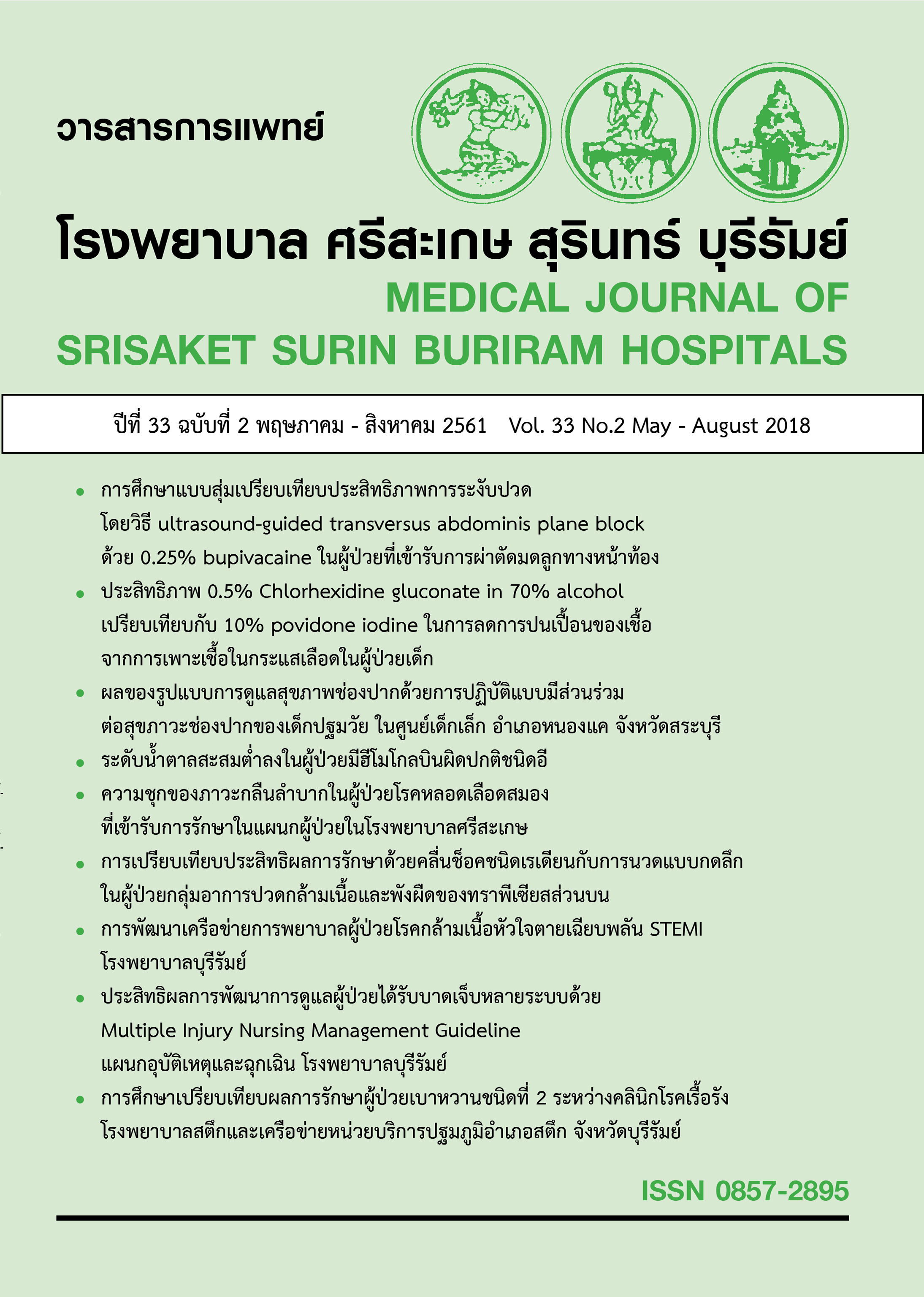ประสิทธิภาพของ 0.5 % chlorhexidine gluconate in 70 % alcohol เปรียบเทียบกับ 10% povidone iodine ในการลดการปนเปื้อนของเชื้อจากการเพาะเชื้อในกระแสเลือดในผู้ป่วยเด็ก
Main Article Content
บทคัดย่อ
หลักการและเหตุผล: การติดเชื้อในกระแสเลือดในทารกแรกเกิดและเด็ก เป็นสาเหตุการตายและความพิการในประเทศไทยที่พบบ่อย การเพาะเชื้อในกระแสเลือดเป็นวิธีมาตรฐานในการวินิจฉัยการติดเชื้อในกระแสเลือด แต่ผลการเพาะเชื้อในกระแสเลือดขึ้นเชื้อแบคทีเรียปนเปื้อนได้บ่อย ทำให้ผู้ป่วยต้องนอนโรงพยาบาลนานขึ้นและค่าใช้จ่ายเพิ่มขึ้น ได้มีการนำน้ำยาฆ่าเชื้อเพื่อใช้ในการลดการปนเปื้อนของการเพาะเชื้อ ได้แก่ povidone iodine และ chlorhexidine gluconate มาใช้ทำความสะอาดผิวหนังก่อนทำการเพาะเชื้อในกระแสเลือดอย่างแพร่หลาย
วัตถุประสงค์: เพื่อเปรียบเทียบประสิทธิภาพของ 0.5% chlorhexidine gluconate in 70% alcohol เปรียบเทียบกับ 10% povidone iodine ในการลดการปนเปื้อนของเชื้อจากการเพาะเชื้อในกระแสเลือดในผู้ป่วยเด็ก ในโรงพยาบาลละหานทราย จังหวัดบุรีรัมย์
สถานที่ศึกษา: โรงพยาบาลละหานทราย จังหวัดบุรีรัมย์
รูปแบบงานวิจัย: การศึกษาทางคลินิกชนิดไปข้างหน้า ( prospective study )
วิธีการศึกษา: ผู้ป่วยเด็กแรกเกิดถึงอายุ 15 ปี ที่เข้ารับการรักษาที่ตึกผู้ป่วยนอก ห้องฉุกเฉิน หอผู้ป่วยกุมารเวชกรรม และทารกแรกเกิดป่วย ณ โรงพยาบาลละหานทราย ที่สงสัยติดเชื้อในกระแสเลือดและแพทย์สั่งเพาะเชื้อในกระแสเลือดในช่วงระยะเวลา 1 ปี ตั้งแต่ 1 สิงหาคม 2559 - 31 กรกฎาคม 2560 แบ่งการใช้น้ำยาทำความสะอาดผิวหนังก่อนเจาะเลือดเพื่อส่งเพาะเชื้อเป็น 2 กลุ่ม กลุ่มที่ 1 เช็ดผิวหนังบริเวณที่จะเจาะเลือดด้วย 10% povidone iodine แก่ผู้ป่วยทุกรายที่เข้าร่วมการศึกษาในเดือนคี่ กลุ่มที่ 2 เช็ดผิวหนังบริเวณที่จะเจาะเลือดด้วย 0.5% chlorhexidine gluconate in 70% alcohol แก่ผู้ป่วยทุกรายที่เข้าร่วมการศึกษาในเดือนคู่
ผลการศึกษา: จำนวนสิ่งส่งตรวจเพาะเชื้อในกระแสเลือดทั้งหมด 364 สิ่งส่งตรวจ พบขึ้นเชื้อปนเปื้อน 33 สิ่งส่งตรวจ คิดเป็นร้อยละ 9.1 เมื่อเทียบประสิทธิภาพของ 10% povidone iodine กับ 0.5% chlorhexidine gluconate in 70% alcohol ในการลดการปนเปื้อนของเชื้อที่ผิวหนังจากการเพาะเชื้อในกระแสเลือดพบว่ากลุ่มที่ ทำความสะอาดด้วย 10% povidone iodine ขึ้นเชื้อปนเปื้อน 19 สิ่งส่งตรวจ จากสิ่งส่งตรวจทั้งหมด 189 สิ่งส่งตรวจ คิดอัตราขึ้นเชื้อปนเปื้อนเท่ากับ 10.1 กลุ่มที่ ทำความสะอาดผิวหนังด้วย 0.5% chlorhexidine gluconate in 70% alcohol ขึ้นเชื้อปนเปื้อน 14 สิ่งส่งตรวจจากสิ่งส่งตรวจทั้งหมด 175 สิ่งส่งตรวจ คิดอัตราขึ้นเชื้อปนเปื้อนเท่ากับร้อยละ 8.0 โดยไม่มีความแตกต่างอย่างมีนัยสำคัญทางสถิติทั้ง 2 กลุ่ม เชื้อที่ขึ้นมากที่สุดคือ Coagulase negative staphylococci (ร้อยละ 84.9)
สรุป: การใช้น้ำยา 0.5% chlorhexidine gluconate in 70% alcohol ทำความสะอาดผิวหนังก่อนเจาะเลือดเพื่อเพาะเชื้อในกระแสเลือดมีอัตราการขึ้นเชื้อปนเปื้อน น้อยกว่า 10% povidone iodine แต่ไม่มีความแตกต่างกันอย่างมีนัยสำคัญทางสถิติ
คำสำคัญ: ติดเชื้อในกระแสเลือด เชื้อแบคทีเรียปนเปื้อน
Article Details
เอกสารอ้างอิง
2. Hall KK, Lyman JA. Updated review of blood culture contamination. Clin Microbial Rev. 2006;19(4):788-802.
3. Weinbaum FI, Lavie S, Danek M, Sixsmith D, Heinrich GF, Mills SS . Doing it right the first time:Quality improvement and the contaminant blood culture. J Clin Microbiol. 1997;35(3):563-5.
4. Malani A, Trimble K, Parekh V, Chenoweth C, Kaufman S, Saint S. Review of clinical trial of skin antiseptic agents used to reduced blood culture contamination . Infect Control Hosp Epidemiol. 2007;28(7):892-5.
5. Marlowe L, Mistry RD, Coffin S, Leckerman KH, McGowan KL, Dai D, Bell LM, [et.al]. Blood culture contamination rates after skin antisepsis with chlorhexdine gluconate versus povidone-iodinein pediatric emergency departmen. Infect Control Hosp Epidemiol. 2010;31(2):171-6.
6. Suwanpimokul G, Pongkumpai M, SuankratayC. A randomized trial of 2 % Chorhexidine tincture compared with 10 % aqueous povidone-iodine for venipuncture site disinfection: Effects on blood culture contamination rates. J infect. 2008;56(5):354-9.
7. เก่งกาจ อุ่นฤทธิ์, พรอำภา บรรจงมณี, อัจฉรา ตั้งสถาพรพงษ์. ประสิทธิภาพของ 2 % chlorhexidine gluconate in 70 % alcohol เปรียบเทียบกับ 10 % povidone iodine ในการลดการปนเปื้อนของเชื้อจากการเพาะเชื้อในกระแสเลือดในผู้ป่วยเด็ก. วารสารกุมารเวชศาสตร์. 2557;53(1):24-31.
8. Barenfanger J, Drake C, Lawhorn J Verhus SJ. Comparison of chlorhexidine and tincture of iodine for skin antisepsis in preparation for blood sample collection. J Clin Microbiol. 2004;42(4):2216-7.
9. Garland JS, Buck RK, Maloney P. Comparison of 10 % povidone-iodine and 0.5 % chlorhexidine gluconate for the prevention of peripheral intravenous catheter colonization in neonates: a prospective trial. Pediatr Infect Dis J. 1995;14(6):510-6.
10. Tepus D, Fleming E, Cox S, Hazelett S, Kropp D. Effectiveness of chloraprep in reduction of blood culture contamination rates in emergency department. J Nurs Care Qual. 2008;23(3):272-6.


